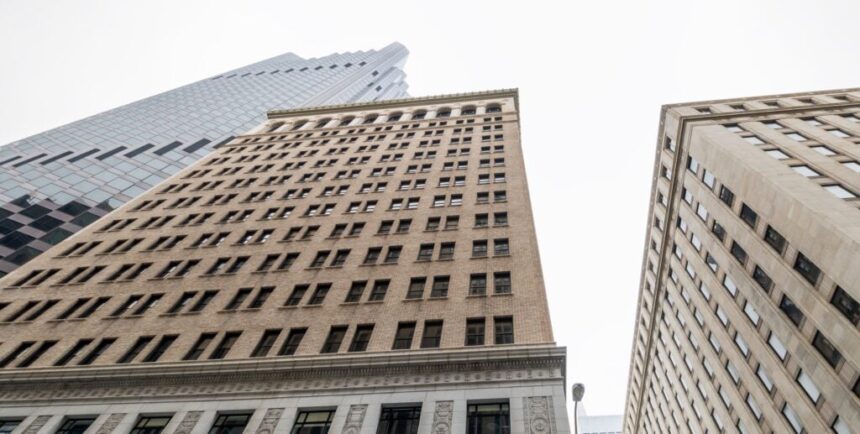Pandemic and post-pandemic behaviors had a pronounced impact on commercial real estate, and that’s set up 2024 to be a year of normalization. Back in April, Morgan Stanley predicted a severe commercial real estate crash. But while the office sector has taken a hit due to hybrid work models that now appear to be permanent, success in the retail sector and resilience in the industrial sector have mitigated risks to commercial real estate overall.
Still, with loans maturing and leases expiring in 2024, there could be more pain ahead, partly depending on the timing and extent of the Fed’s expected rate cuts.
To give you an idea of where things are headed, we evaluated forecasts from several major firms and asked a few experts to weigh in. Here’s what you need to know.
Looking Back at 2023
When the pandemic hit, and remote-capable workers stopped going to the office, it became clear that the office sector would suffer. Because many companies have shifted permanently to hybrid or remote work arrangements, the office sector didn’t bounce back in 2023. By the end of October, the national vacancy rate hit 17.8%, while the office listing rate declined 40 basis points year over year, according to Commercial Edge.
Without commuters to support retailers and restaurants, urban cores experienced a 10% to 20% decline in foot traffic compared to pre-pandemic conditions, according to McKinsey. But suburban retail thrived in 2023 as more people sought amenities near home. Overall, demand for retail space increased in the third quarter, and the vacancy rate dropped to an 18-year low, according to CBRE.
Vacancy rates in the multifamily sector began to rise slightly at the beginning of the year, and rent growth slowed in the third quarter due to delivery of 114,600 new units. While analysts expect rent growth to remain positive, it’s tracking behind inflation. Asset values remained flat for lower-tier apartment buildings, while higher-end apartment building rents declined. The correction is likely to continue into 2024.
The industrial sector was resilient in the face of rising interest rates, in part due to expansion in e-commerce. While construction completions caused an increase in the vacancy rate in the third quarter, new construction starts are down amid high demand for space.
In the third quarter, the average taking rent was up 15.4% year over year, according to CBRE. And while deal volume was significantly suppressed in 2023 as investors pulled back from commercial real estate, industrial property sale prices were up 6.8% year over year as of the third quarter, Commercial Edge reports.
The hotel sector has seen much slower yet positive growth in average daily rates, and occupancy rates have fallen due to waning demand for travel and an increase in supply. Competition from short-term rental hosts and an increase in international travel both played a role in decreased demand for hotel rooms in the U.S.
Overall, commercial real estate may have sustained an impact greater than the numbers depict, according to Jonathan O’Kane, vice president & head of research at Chandan Economics, a commercial real estate consultancy firm.
“Devaluations over the past year-plus were more extreme than most people realize,” O’Kane said in a conversation with BiggerPockets. “According to MSCI Real Assets, commercial property prices are down from their peak by about 10%. However, when we layer in the impact of inflation, so-called ‘real’ prices are down by 15%. In other words, the severity of value loss is about 50% worse than sticker prices alone suggest.” That could mean resiliency in 2024 since the worst of the correction may be behind us.
Looking Ahead to 2024
“As we look ahead to next year, sector-specific functionality questions will remain the driving force in valuations,” O’Kane added. “However, those waiting for a more substantial industry-wide correction to materialize might want to check their rearview mirrors.”
High interest rates are deterring commercial real estate investors from borrowing money, but that trend could begin to reverse in 2024, according to David Camins, partner at Xroads Advisors, in a conversation with BiggerPockets. “I anticipate in 2024, the activity in sales, lending, and leasing will tick up, and a low in the tide of the market will be found,” explained Camins. He expects the tide to remain low for a while as a high volume of loans roll over and become due at staggered times.
Here’s what experts are forecasting in each sector.
Multifamily
Rent growth will likely remain sluggish in 2024 since we have yet to feel the full impact of peak new construction deliveries in 2023. In markets with the most new construction projects, rents could face a decline, but prices may also drop as the gap between supply and demand shrinks, presenting an opportunity for investors to find deals.
However, several firms expect multifamily housing starts to drop significantly in 2024, which could lead to fewer completions as early as the third quarter of 2024 and normalization going into 2025.
In other words, the window of opportunity to get properties at low prices may be small. And rent growth may not be flat for long. Ryan Severino, chief economist and head of U.S. research at BGO, expects the apartment sector to stabilize by the end of 2024.
“By the end of next year, we project that the national vacancy rate should stabilize and thereafter start declining once again,” Severino said when speaking with BiggerPockets. “Rent growth should slow throughout next year and then reaccelerate once the market stabilizes.”
Retail
“Retail has quietly transitioned to its tightest market in history, as measured by CoStar’s national
vacancy rate,” said Severino. The resilience of the sector is partly due to low supply, as new construction starts have been scarce for years. Supply will remain low in 2024, as construction and borrowing costs make it impossible to earn profit from new developments in all but a few markets.
However, CBRE notes that not all retail space is in high demand. Enclosed shopping malls may continue to lose stores, while occupancy will remain strong in suburban open-air shopping centers. Retail spaces may continue to sit empty in urban cores due to high crime rates and low foot traffic from office workers.
“Until the local and state governments place a greater emphasis on safety in our big cities, the return to office figures will continue to struggle, and retailers and restaurants will be hesitant to reopen in the business districts,” said Camins.
Office
The office sector may face further declines in occupancy, or it may have hit a trough, but it’s unlikely to bounce back to pre-pandemic levels anytime soon. Newer buildings packed with amenities will continue to draw the most leasing activity, especially in live-work-shop submarkets, while older office buildings will likely continue to suffer.
Office supply may decrease slightly as new construction starts are expected to hit a 10-year low and more office conversion projects take place with support from the federal government. But demand is unlikely to pick up and may even decline, causing little movement in prices and stagnating rents.
“Looking ahead to 2024 from an office perspective, it’s hard to predict a material change from 2023, as most tenants with leases expiring will continue to downsize,” said Camins. “There are tenants that are expanding and growing, but the downsizers will continue to outpace the expanding tenants.”
Industrial
According to Severino, the industrial sector is expected to continue to normalize after a period of unsustainable growth. “Our proprietary modeling suggests that normalization should persist throughout 2024,” he says. CBRE notes that new deliveries will push up the vacancy rate in the first half of the year before slight declines in the third and fourth quarters due to a tapering supply. J.P. Morgan predicts strong and stable long-term growth despite softening in 2024.
“By the end of next year, we project that the national vacancy rate should stabilize and thereafter start declining once again,” said Severino. “Correspondingly, rent growth should slow throughout next year and then reaccelerate once the market stabilizes.”
Outcomes look better for industrial real estate than any other sector, according to Severino: “We continue to forecast that the industrial market should produce the strongest rent growth of the major property sectors over our five-year forecast horizon.”
Hotels
Suppressed consumer spending in 2024, along with competition from alternative lodging options like Airbnb, will continue to put downward pressure on the average revenue per room (RevPAR). However, international travel could bounce back in 2024, potentially bringing in about 4.7 million overseas travelers and lifting the hotel occupancy rate in the U.S., according to CBRE. The firm predicts a 3% baseline increase in RevPAR but notes that more than a -5 % decrease is possible.
PwC’s forecast expects a 2.7% year-over-year increase in RevPAR. CBRE notes that even if hotels don’t experience a decline in RevPAR, hotel profits are expected to fall due to rising costs, wage inflation, and other factors. Upper-midscale hotels will have the most success, as is generally true during an economic downturn. Some cities, like Chicago, may fare better than others due to tight supply.
The Bottom Line
After pandemic-induced volatility in commercial real estate, many sectors are poised to stabilize in 2024. While each sector faces various challenges, there are also opportunities for investors to grow their portfolios with the right assets. Those may include multifamily buildings at bargain prices or live-work-shop retail developments in the suburbs with strong rental metrics.
Across asset classes, innovations in technology and energy-efficient upgrades will be advantageous to investors as they face increasing costs and potentially waning demand from tenants.
More from BiggerPockets: 2024 State of Real Estate Investing Report
After more than a decade of clearly favorable investing conditions, market dynamics have shifted. Conditions for investment are now more nuanced, and more uncertain. Download the 2024 State of Real Estate Investing report written by Dave Meyer, to find out which strategies and tactics are best suited to win in 2024.

Note By BiggerPockets: These are opinions written by the author and do not necessarily represent the opinions of BiggerPockets.








